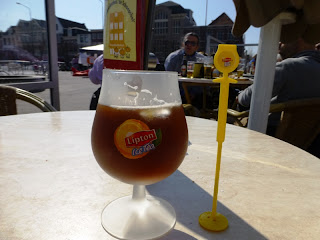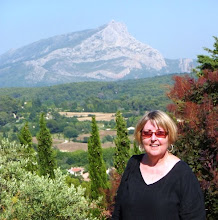Our first excursion after resting from the flight was to Haarlem. My goals were to go to the Franz Hals Museum, have lunch, see the exhibition, get Museumkaarts for the both of us and then visit Corrie Ten Boom's house. We did get all that done with minimal confusion.
I took no pictures at the
Franz Hals Museum. We put our coats in a locker, had a nice little lunch in the museum cafeteria, got our tickets for the special exhibition, got our English headsets and saw a great exhibition that featured the works of Franz Hals compared to other painters of the time doing the same or a very similar subject. We were both enthralled.
The Netherlands has a great deal with the Museumkaart. It is for the entire country and lets you into a large number of museums for free or for greatly reduced prices. It worked almost everywhere we went.
This is a typical residential street in Haarlem.
Corrie Ten Boom's house is above the jewelry store. The
Ten Booms were devout Christians who hid Jews and Dutch resistance fighters during WWII. Most of those they hid survived the war. I can't remember the number of people they saved, but we did learn that those who hid from the Nazis in the Netherlands were far more likely to survive than those who were sent to the camps.
This is blurry and the lights are from behind me in the dark alley. Click on it to read it better.
This is the front door.
This is an opening into the actual hiding place. It's the size of a narrow closet. There were other hiding locations in the house. It was searched many times, but no one was ever found. However, the last time, evidence of others living there was found and that's what sent the Ten Booms to the camps.
The guide has a brother who lives here in Tucson and she lived with him for a year a few years back. Small world.
This is inside the small hiding place behind the wall.
Part of the evidence found were ration cards hidden behind the stair cap. There were too many for the number of known residents of the house.
The entrance to the hiding place is through the closet on the left.
This is the square in Haarlem. We didn't spend much time here. We just walked back to where our car was parked, got some drinks at a local market on the way, got our car and headed home to Zandvoort.
There were 3 reasons I wanted to go to Arnhem: to visit the Kroller-Muller Museum, to visit the Airborne Museum and to go to the Open Air Museum. We got to two of them before Trout got so sick. We ended up spending the Open Air Museum day in the room of our hotel.
So here is the
Kroller-Muller. Of course I didn't take any interior pictures, but we saw some great paintings and sculptures. I saw Van Goghs that I had never seen before in books or in person.
We took a break on this patio. It wasn't exactly warm. The trees aren't leafed out yet.
Yeah, they use a bit of English in Holland.
This is a modern art museum and this is one of the sculptures in the front.
Trout loved this bird.
He took a pretty good picture of me with the Mark de Suvero behind me and Monsieur Jacques in front. He's everyone's favorite posing buddy.
The Kroller-Muller is in the largest park in the Netherlands, the
Hoge Veluwe. To drive to the museum, you have to get a special ticket. You can park outside the entrance and pay less if you want. You can walk or bring your own bike, but the most popular option seems to be to use one of the free bikes to get around. This is what they look like. As you can tell, all seem to have child seats on the back.
The other place we managed to get to before Trout got sick was the
Airborne Museum. Some of you may have heard of
Operation Market Garden or the book or movie,
A Bridge Too Far. This museum is devoted to that operation and battle that took place near Arnhem in September, 1944. I knew nothing about this except for the name of the movie until I started researching for the trip. The documentary film and exhibition at the museum is quite moving.
Because we didn't pay for me to drive the car, I stuck around the room in Arnhem with Trout while he was sick. I was still recovering a bit from my own issues, so sleeping most of the day and not eating much was good for me. I did have to go out and feed the parking meter, so I took a few pictures of the immediate neighborhood from our balcony. Te koop means for sale.
We didn't make it to the
Open Air Museum, but most countries have one or more, so I hope to see one in Scandinavia next summer, maybe with Vikings.
The last smallish town we visited in the Netherlands was Leiden. It's a college town and we saw lots of student housing down the street from our small hotel which was right on this canal.
This is a close up of a small street just around the corner from our street.
This is a square a few blocks from us near the train station. Supposedly, the pilgrims left for the New World from Leiden, hence the Mayflower Hotel in the background.
Trout loved these kids in the life vests. It really wasn't for the fountain. They'd just gotten off a canal boat and run over to the spurting water.
Bicycles everywhere, of course.
The canal looks fine in these pictures, but it did have lots of trash in it -- more around where the students lived. I guess there are spoiled brats everywhere.
That old church in the background is the Protestant Marekerk. Completed in 1650, it's the first church built in Leiden after the Reformation.
We both liked this typical Dutch bridge that can be moved to accommodate a tall masted sail boat.
On the street where we stayed and between our small hotel and the square was this museum, The
Museum De Lakenhal. It is in the former clothmaker's hall from 1640. The hall was designed by the same architect as the Marekerk, Arent van Gravesande. Although it holds few masterpieces, we thought it was a lovely little museum.
I liked this little domestic scene.
I particularly like this painting showing the Marekerk from the pictures above.
And we thought the stained glass from all eras was wonderful.
These rooms are very close to what they were like when they served the clothmakers in the 17th century.
You'll have to click on this picture to get an idea of all the "correct" colors of black cloth.
And this is a chalkboard attendance roster, I guess. Note the date.
This is the grand hall with 17th century furniture.
Here's a tapestry depicting the Siege of 1420.
And an original staircase with stained glass.
On one of the sunny days, we sat in the square. I had iced tea. It was sparkling. They provide those plunger looking things to push the lemon into the bottom of the glass and squeeze it.
There's the windmill museum which will be the subject of an entire post soon.
People were sitting outside their houses in the sun that afternoon. These folks are between their parked cars and the canal.
This woman was bundled up a bit but sitting on the sidewalk in front of the house.
Depending on which way you looked down the one-way street you have house, sidewalk, street, parking area, narrow walkway, canal. Each building has a small area that can be decorated or have a seat of some type. You can see the marked off area in white beyond the bench. The rest of the sidewalk has to be left open for foot traffic.
Here the people are within their area which has some pillars and a different color of brick to show where it is.
Now for something entirely different... This was what came with our coffee at an Italian place we ate in Leiden. I always forget that when you order coffee in Europe you almost always get some kind of little sweet treat with it. The blue packages were the sweet treat. There was cream in the red ones very similar to ours, honey, sugar crystals and some kind of non-sugar sweetener. I was pleasantly surprised last year when I bought what I thought would be a box of Stevia packets and it turned out to be the typical tumbled cubes that are so common in Europe. I love those whether they are white or brown sugar and I wish I could find them or the cubed Stevia here. I took this picture because I had not been served sugar crystals like this before.

































































































